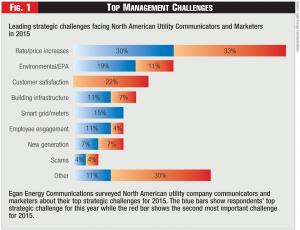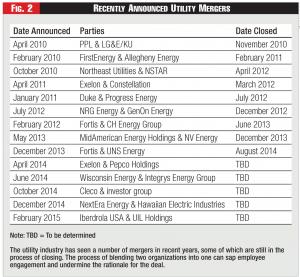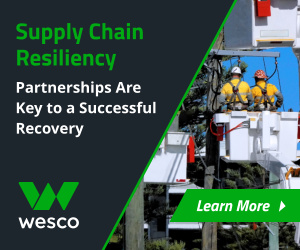To win hearts and minds, it takes more than a t-shirt and a coffee mug.
John Egan is President of Egan Energy Communications, Inc. (www.eganenergy.com), based in Lafayette, Colorado – a national communications firm that works with utilities to improve messaging and communications with employees and stakeholders.
I sensed trouble right away, on the morning of Day One, when my colleagues and I started gathering to meet in the company auditorium. My employer had been acquired by another company, and we were going to hear all about it - both from our former supervisors, and from the new management that had taken us over.

On entering the auditorium, I was given a golf shirt with the logo of the acquiring company (whose name I will not share, but it should be well known to Fortnightly readers.) The size of my shirt was XL. That would fit me, but my female colleagues who weighed 100 lbs. less than I did also received XL-sized shirts. Maybe that was an oversight or a logistical snafu. Or maybe our new bosses had embraced a "one size fits all" view about the workplace - they would determine the metaphorical "size," and we would either learn to fit in that slot, or we would leave.
And my concerns only increased when I found my seat. There, placed carefully on the chair, was a coffee mug with the acquiring company's logo on it, plus a similarly adorned baseball cap and pad of paper.
Now let's fast-forward five years. The acquisition eventually failed, as many strategic initiatives do, and its flameout provided real-world validation of something I had heard in one of my MBA classes a few years earlier: namely, that any merger or strategic initiative launched with a burst of golf shirts, coffee mugs, upbeat banners, clever slogans, and lots of happy talk from executives about "strategic synergies" would soon hit the rocks. It was just a matter of time.
"Don't forget," my professor had advised, "that the first two letters of the word, 'merger,' are ME - employees want to know how a strategic initiative will affect them specifically and personally." And she was also a change-management consultant, who knew her stuff.
 Figure 1 - Top Management Challenges
Figure 1 - Top Management Challenges
"Before you can talk about the strategic reasons to enter a new market or how 1 + 1 will equal 3," she told us, "employees need to know a few basic things," including:
- Will I be a victim of 'headcount rationalization?'
- Will I have a new boss?
- Will I have new responsibilities?
- Will I have to relocate?
- Will you want me to change how I do what I do?"
My experience and my professor's words floated back to me recently as I prepared Budgets, Gadgets & Price Increases, my company's 2015 survey of utility company communicators and marketers. One of the questions we asked respondents concerned their top strategic challenges for 2015. Figure 1 summarizes the results for that question.
I was not surprised by some of the priorities listed by respondents: price increase communications, environmental regulation and customer satisfaction are all long-standing challenges facing communicators and marketers at North American electric and gas utilities.
But I was intrigued - though not particularly surprised - to see that 15 percent of respondents said employee engagement as their #1 or #2 challenge for 2015. Over the years, friends, colleagues and clients have shared stories with me about their efforts to measure and improve employee engagement. But I didn't know if those stories were random anecdotes or a fair representation of a broad industry-wide challenge. Now we have quantitative evidence that employee engagement is a top strategic issue facing North American electric and gas utilities.
 Figure 2 - Recently Announced Utility Mergers
Figure 2 - Recently Announced Utility Mergers
When you think about it, it should not be especially surprising that utility employees are feeling disengaged and beaten down. There is a tremendous amount of change hitting electric and gas utilities. The commitment shown by your employees is being put to the test by any number of factors, both external and internal. Here are some of the most important internal factors roiling utilities and sapping employee commitment:
- Systems integrations, digital meter rollouts, and other IT upgrades and process redesigns,
- Repeated reorganizations and staff reductions,
- Lack of opportunities for professional advancement,
- Poor or infrequent communications about the progress of strategic initiatives, and
- Leadership changes.
But if employees are more committed, they will work harder to remedy difficult internal and external problems. Employee engagement can even become a company strength that supports utilities through challenging times. Looking ahead, no one I know thinks there will be a shortage of challenges facing utilities. So consider employee engagement a strategic investment in coping with disruptive change.
Utilities are not alone in facing a disengaged workforce. A Gallup global poll across numerous industries found only 13 percent of employees said they were actively engaged at work, meaning they were "psychologically committed to their jobs and likely to be making positive contributions to their organizations." Nearly twice as many - 24 percent - identified themselves as actively disengaged. The remaining 63 percent said they were simply (or passively) disengaged.
A Harvard Business Review study from 2013 found 72 percent of those surveyed said employee engagement was very important for an organization to achieve its goals. But only 24% said employees in their organization were highly engaged.
In a 2013 report, PricewaterhouseCoopers found 79 percent of businesses are worried seriously about engagement and retention. Two-thirds of business leaders surveyed said "the overwhelmed employee" was a top business challenge.
Like all enterprises, utilities can only succeed if their employees bring their energies, hearts and minds to work. That's where the answers live to all the vexing problems utilities face. Showing up may account for 80 percent of life, as Woody Allen once asserted, but utility leaders need that other 20 percent from their employees if they want to be truly successful and competitive.
"Employee engagement is key to the success of strategic initiatives especially if an initiative has significant employee and customer impacts," notes Colleen Campbell, who heads the Organizational Change Management Practice at Centric Consulting. "Your employees are the front line to the customer. They are often a cost-competitive resource with great ideas and know-how to address challenges.
"The key is to effectively empower employees to create solutions and support in the process," she continues. "Learn to trust that they have the answers. And since employee engagement ranks high as a key factor to employee retention, this is a wise investment."
What utility today is not concerned about keeping its high-performing employees coming back to work each day?
Who else but actively engaged employees would be willing to go the extra mile to lead a cross-functional team, spot and address a new threat to the business model, fix a process or drive the creation of a new service? These are hard tasks that require a lot of time and energy to remedy. They won't get done well by employees who are disengaged, let alone by actively disengaged, employees.
"There's nothing more dispiriting to employees than getting a new assignment with no tools or training, or poor tools or training," Christina Kelly, director of communications and marketing at Mosaic, told me.
"It happens frequently with IT systems integration. A firm is hired to install an expensive piece of software, hardware, or both, and that's what they focus on. When the system goes live, they see their engagement as over. They hand the training manual to the utility's project manager and let him or her worry about employee training."
"A strategic technology upgrade's 'Go Live' date isn't the end - it's just the beginning," Kelly continued. "You might be surprised how often utilities spend heavily on a strategic technology project without the requisite investment in employee training. Communications - including, but not limited to training - is the cornerstone of employee engagement. That includes giving employees the tools to do their jobs, and communicating frequently with them about how the upcoming changes will affect their jobs."
An organizational change initiative must accompany any strategic initiative, or the initiative will fail. Kelly listed a few tips for a successful organizational change initiative:
- Make employees part of the process to ensure buy-in.
- Explain repeatedly what will change and how it will affect employees.
- Repeat key messages - far more often than you think is necessary. Not every employee "gets it" the first time.
- Use multiple channels for communications.
- Face-to-face communication is optimal. Employees need to be able to assess the messenger as well as the message.
- Seek and listen to feedback: Effective communications is a two-way street.
- For utilities that operate across a wide geographic area, consider holding "road shows" at each regional office.
And don't forget: The more changes that managers and employees have been through, the more skeptical and jaundiced they are likely to be about each successive program. You can hardly blame them for waiting until the enthusiasm over this or that change initiative dies out.
Sad but true: Sooner or later, many leaders will embrace some other hot management imperative and forget about employee engagement.
There's no one way to communicate effectively during strategic change. Each organization has its own unique set of historical and cultural characteristics, and any change-management initiative must take place within the unique confines and characteristics of a utility's organizational culture. But there are a few "no regrets" ideas that could shape your particular initiative.
Campbell of Centric Consulting recommends engaging all employees by helping them understand high-level strategic initiatives through effective change-management campaigns. "Employees want to know what direction leadership is taking," she said. "Centric has supported many organizations facing unengaged or unmotivated employees that don't understand the company vision, direction or key initiatives."
Recently Centric supported an organization where the employees rated their "Understanding of Corporation Direction" as a low score of "2" on a scale from 1-10. With an intensive combination of leadership alignment, cascading messaging, creative lunch-and-learns , key initiatives fair, engaged employee change agents and presentations by employees for each initiative, the score jumped to a new high of "8" with three months.
"The key is to sponsor the effort, educate employees, trust they know the answers and let employees develop the solutions," she noted.
If utilities fail to provide employees with challenging, satisfying work, they will not have engaged, committed employees. Utilities will get the best out of their employees to the extent they create and sustain an environment where employees are challenged to perform meaningful work and they have the opportunity to grow professionally and advance. Everything else is lipstick on a pig.



